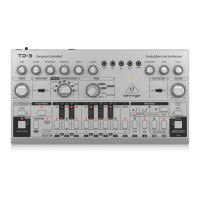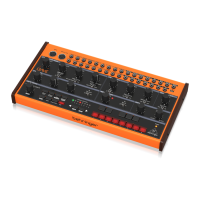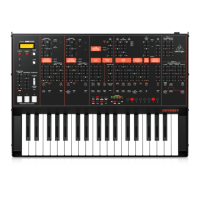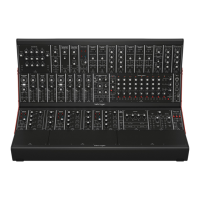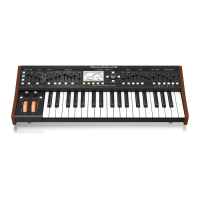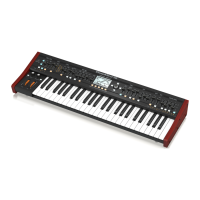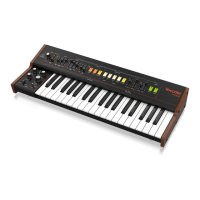(EN) Step 3: Getting Started
OVERVIEW
This ‘getting started’ guide will help you set up the EDGE and briey introduce its capabilities.
CONNECTION
To connect the EDGE to your system, please consult the connection guide earlier in this document.
SOFTWARE SETUP
The EDGE is a USB Class Compliant MIDI device, and so no driver installation is required. The EDGE does not require any additional drivers
to work with Windows and MacOS.
HARDWARE SETUP
Make all the connections in your system. Keep the EDGE power turned o when making any connections.
Ensure your sound system is turned down.
Turn on the EDGE before turning on any power ampliers and turn it o last. This will help prevent any turn on or turn o “pops or
thumps” in your speakers.
WARM UP TIME
We recommend leaving 15 minutes or more time for the EDGE to warm up before recording or live performance. (Longer if it has been
brought in from the cold.) This will allow the precision analog circuits time to reach their normal operating temperature and
tuned performance.
OCILLATOR (VCO) SECTION
The EDGE has two main voltage controlled oscillator (VCO).
The VCO waveforms can be selected from pulse or triangle. The frequency can be adjusted up or down over ten octaves and allow ne
tuning to other instruments.
The VCO may be modulated in frequency. The source of the modulation can either be the envelope as detailed below, or vi the OSC 1&2 CV
input in the patch bay.
The amount or depth of VCO envelope modulation can be adjusted using the ENVELOPE or EG DECAY (VCO 1&2) control.
Use the LEVEL control to adjust the mix between the internal VCO. The internal noise generator can be added by urning the NOISE/EXT CW.
If an external input signal is present at the EXT AUDIO input, then this will take the place of the noise in the mix.
FILTER (VCF) SECTION
Play with the cuto frequency, and resonance controls, and listen to their eects on the sound.
The classic 24 dB/octave high pass and low pass lters allow a great deal of control over the sounds created by EDGE.
The high-pass lter reduces the level of signals that are below the cuto frequency. It eectively reduces the level of the fundamental,
and lower order harmonics.
The low-pass lter reduces the level of signals that are above the cuto frequency. It reduces the levels of the higher-order harmonics.
The resonance control gives an enhancement to the signals at the crossover frequency.
The amount of VCF modulation can be varied with the NOISE/VCF MOD control. This will add noise if no audio is preset in the EXT AUDIO
input in patch bay.
The VCF ENVELOPE is dedicated to modulating the Cuto Frequency of the Filter. The Decay time of this envelope is set using the VCF
DECAY control. This value may also be aected by the Sequencer 8 VELOCITY controls. The 8 levels are connected to the Velocity inputs of
the Envelope, providing an extra source of control to both the amount and decay time of the Filter envelope.
All these features, in addition to using the patch bay, allows for a great deal of exibility in sound creation.
PATCH BAY SECTION
This section allows you the versatility to create many dierent sounds, with an endless variety of options and congurations. Below are 3
patch ideas to try:
OSC 1 Out to OSC 2 CV IN for some interesting modulation.
VELOCITY OUT to 1-2FM AMT. This now adds FM tones at varying amounts using the velocity sequencer.
PITCH OUT to VCA DECAY IN. This adds variation into the decay controlled by the sequencer PITCH levels.
Caution: Do not overload the 3.5 mm inputs. They can only accept the correct level of voltages as shown in the specication tables. The
3.5 mm outputs should only be connected to inputs capable of receiving the output voltages. Failure to follow these instructions may
damage the EDGE or external units.
FIRST SOUNDS
The following steps will help you start making sounds from your new synthesizer once connected:
Turn up the volume control.
Set the clock to INT.
Set all controls to the default patch levels in the diagram.
Press PLAY/STOP.
You should now hear a repeating pattern.
FIRMWARE UPDATE
Please check the behringer.com website regularly forany updates to theBehringer SYNTHTRIBE app.
Theapp looks for the latestrmware lewhich can thenbe downloaded and used to update the EDGE.
EDGE SYNTHTRIBE
The SYNTHTRIBE application allows you to select the MIDI channel number and to set and adjust various parameters
of the EDGE to suit your preferences. Connect the EDGE to your computer via USB and run the application (PC or MacOS).
Check our website regularly for any updates to SYNTHTRIBE or EDGE documentation.
Typical Synthtribe image
EDGE Getting Started
38 39Quick Start GuideEDGE
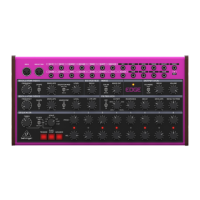
